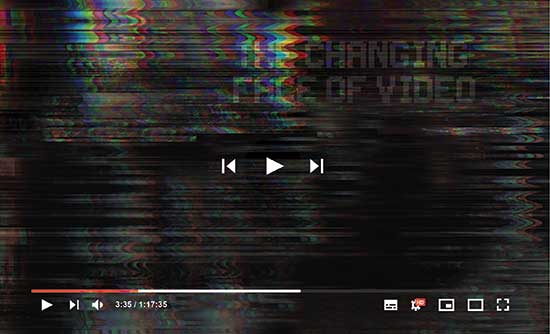The Changing Face Of Video
The world we live in today is fast changing and hard to keep up with. Technology has evolved immensely, so when video marketing was first introduced most people probably didn’t realize how much of a history it already had.
Video marketing goes all the way back to 1941, when Bulova ran the first commercial on television. Forty years later in 1981, MTV launched “Video Killed the Radio Star” — its first music video. A couple years after that, Apple introduced the Macintosh personal computer with its iconic “1984” commercial — and we all know what happened there.
Over the next 12 years, the use of the personal computer became more prevalent, and the commercials created for television were now being seen on the small computer screen. In 1995, we saw the first viral video, “The Spirit of Christmas,” a video Christmas card commissioned by a television executive. It was passed around on VHS tape to friends until someone had the idea to upload it to the internet.
However, the biggest platform was yet to be born: YouTube. Created in 2005, it became an instant success as marketers and numerous big-name brands saw a new advertising opportunity. A short year later, Google bought it for a whopping $1.65 billion because it saw the impact video played in internet searching and marketing.
A surge in video as a content marketing format was seen in 2016, and when 2017 rolled around, video marketing rose to the top of the marketing list. In 2018, video moved from a singular marketing tactic to an entire business strategy. By 2019, it became a conversational, actionable and measurable medium. As you can see, video has had quite a history.
VIDEO IS KING
According to a HubSpot Research study, more than 50% of consumers want to see video more than any other type of content. The same report revealed video, when used on landing pages, is capable of increasing conversion rates by over 80% and the mere mention of the word “video” in an email subject line increases open rates by 19%.
The popularity of video is easy to understand. It has become so integrated into our daily life we don’t even realize it. We literally carry it in our pockets and purses. We talk to it, and put it in our refrigerators and our cars. We love video because it’s easy to consume. A recent study revealed the average human brain can process videos 60,000 times faster than text, and with approximately 65% of the population being visual learners, marketers realized they could relate to the consumer more quickly through video. Now, video is used for tutorials, product launches, branding efforts, webinars, demonstrations, expert interviews, customer testimonials and even live- streaming events.
[VIDEOS HAVE] PROGRESSED FROM SIMPLY INFORMING THE CONSUMER OF THE BENEFIT AND USES OF A PRODUCT OR SERVICE TO BEING “INFOTAINMENT” PIECES.
Video is everywhere. Recent results from the Wyzowl State of Video Marketing Survey showed 81% of businesses use video as a marketing tool. Internet users watch an average of 1.5 hours of video online per day. By 2021, over 239 million people will have watched an online video.
At first glance, those statistics are exciting. More people are watching your video and asking for more! It’s good news for those with a cohesive marketing strategy and even for those just getting into it. Your customer is already out there waiting for you and you know how to find and connect with them.
A SATURATED MEDIUM
But there are downsides to this hot, flashy marketing tool. The first one is saturation. If your customer is watching video (and asking for more) you know they’re ready for your video. Unfortunately, though, they’re also ready for everyone else’s.
I’m sure you’ve heard the average attention span is about six seconds and it’s no wonder. The average person is introduced to 50,000 marketing messages every day. With all those messages fighting for the consumer’s attention, standing out in this barrage of clutter is the biggest challenge.
When video first started merely having one made you different, but today anybody with a smartphone can create a video. As a result, content creators have become much more creative in their efforts to capture the customer’s attention. Videos have become entertaining. They’ve progressed from simply informing the consumer of the benefit and uses of a product or service to being “infotainment” pieces.
WITH ALL THE SOCIAL MEDIA SITES AND PLATFORMS AVAILABLE, IT’SNOT ENOUGH TO POST ON ONLY ONE PLATFORM.
So, how do you make your video entertaining and still be informative? Keep it engaging. If it’s a product launch, don’t simply tout the features of the product. Explain why the company felt the need for it. What was the thought process during research and development? Is it solving a problem? Tell the story behind it and present the solution. HubSpot Research found videos on Twitter that started with setting up a problem, then presenting a solution in the end were more likely to be watched all the way through.
Retailers who use video can talk about who they are and why their store differs from others. Use video to explain what you do, whether it’s training classes or weekly promotions. The video doesn’t have to be long, but it does have to be interesting and hosted by someone who is engaging and welcoming.
GREATER SATURATION, GREATER FRAGMENTATION
Even though it’s the latest, greatest marketing medium, the technology behind video changes so quickly it’s hard to keep up. Every day new and different challenges present themselves. The most pressing challenge is it has to be maintained or it will very quickly lose what value and momentum it has gained.
With all the social media sites and platforms available, it’s not enough to post on only one platform. It’s not realistic to expect if you post only to YouTube, the consumer will see it. Properly distributing your video across all platforms ensures it is viewed by both current and potential customers. According to a study by Socialbakers, video is the top performing post on Facebook, offering an astonishing 135% organic reach over still images. On Twitter, HubSpot reports video is six times more likely to be retweeted.
Today, if you want to get the most out of your video be prepared to post it on all platforms, including email blasts and newsletters with links driving the customer back to your website. Yes, you’ll probably have to create a slightly different type of content for each platform as each one has its own format restrictions — and it may mean hiring a social media guru or learning the individual platforms yourself. Which begs the question: Is it worth it?
TIME VS. REWARD
It goes without saying: Video will keep evolving, becoming more sophisticated in its production and avenues of distribution. But it’s also growing in engagement delivery, with the potential to grow your business. The little bit of extra effort it takes to keep up with the changing world of video can bring great rewards in the long run. Remember, you’re not alone. There are companies and platforms ready to offer their services to help you compete — don’t be afraid to use them. You’ll reap the rewards in the end!






